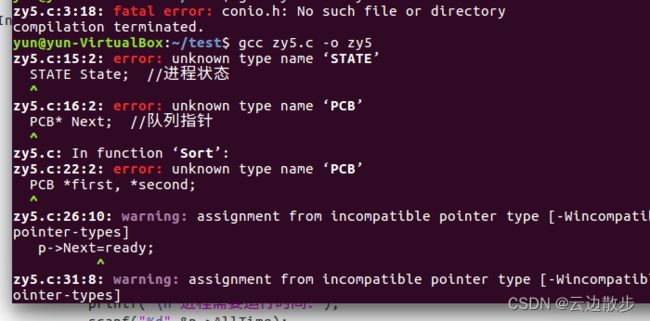操作系统原理实验2:进程调度(在Ubuntu虚拟机gcc编译环境下
|
通过一个简单的进程调度模拟程序的实现,加深对各种进程调度算法,进程切换的理解。 |
| 实验原理与内容 1、进程调度算法:采用动态最高优先数优先的调度算法(即把处理机分配给优先数最高的进程)。 2、每个进程有一个进程控制块(PCB)表示。进程控制块可以包含如下信息:
3、调度原则
老师给的代码(具有不少错误的): #include #include enum STATE{ Ready=1,Run,Block,Finish }; struct PCB{ int ID; //进程名 int Priority; //优先数 int Time; //到达时间 int AllTime; //进程还需要运行时间 int CPUTime; //已用CPU时间 int StartBlock; //进程的进入阻塞时间 int StartTime; //进程的等待阻塞时间 STATE State; //进程状态 PCB* Next; //队列指针 }*ready=NULL,*p; void Sort(){ // 建立对进程进行优先级排列函数 PCB *first, *second; int insert=0; if(ready==NULL||(p->Priority>ready->Priority)) //优先级最大者,插入队首 { p->Next=ready; ready=p; } else // 进程比较优先级,插入适当的位置中 { first=ready; second=first->Next; while(second!=NULL) { if(p->Priority>second->Priority) //若插入进程比当前进程优先数大 { //插入到当前进程前面 p->Next=second; first->Next=p; second=NULL; insert=1; } else // 插入进程优先数最低,则插入到队尾 { first=first->Next; second=second->Next; } } if(insert==0) first->Next=p; } } void Input() { // 输入进程控制块信息 int i,num; //clrscr(); /*清屏*/ printf("\n 请输入进程数量:"); scanf("%d",&num); for(i=0;i { p=(PCB*)malloc(sizeof(PCB)); //动态生成 p->ID=i+1; printf("\n 输入进程%d的信息:\n",p->ID); printf("\n 程优先数:"); scanf("%d",&p->Priority); printf("\n 进程需要运行时间:"); scanf("%d",&p->AllTime); p->Time=3*i; p->CPUTime=0; p->StartBlock=0; p->StartTime=0; p->State=Ready; p->Next=NULL; printf("\n"); Sort(); /* 调用sort函数*/ } } int Length() { int l=0; PCB* pr=ready; while(pr!=NULL) { l++; pr=pr->Next; } return(l); } void OutPut(PCB * pr) //显示当前进程 { printf("\n ID \t state \t Priority \t ALLTime \t CPUTime \n"); printf("%d\t",pr->ID); printf("%d\t",pr->State); printf("%d\t",pr->Priority); printf("%d\t",pr->AllTime); printf("%d\t",pr->CPUTime); printf("\n"); } void Check() // 建立进程查看函数 { PCB* pr; printf("\n **** 当前正在运行的进程是:\n"); //显示当前运行进程 OutPut(p); pr=ready; printf("\n ****当前就绪队列状态为:\n"); //显示就绪队列状态 while(pr!=NULL) { OutPut(pr); pr=pr->Next; } } void Destroy() //建立进程撤消函数(进程运行结束,撤消进程) { printf("\n 进程 [%d] 已完成.\n",p->ID); free(p); } void Running() // 建立进程就绪函数(进程运行时间到,置就绪状态 { p->CPUTime++; p->State=Run; if(p->CPUTime==p->AllTime) Destroy(); //调用Destroy函数 else { (p->Priority)--; p->State=Ready; Sort(); //调用sort函数 } } void main() //主函数 { int len,h=0; char ch; Input(); len=Length(); while((len!=0)&&(ready!=NULL)) { ch=getchar(); h++; printf("\n 执行进程号:%d \n",h); p=ready; ready=p->Next; p->Next=NULL; p->State=Ready; Check(); Running(); printf("\n 按任一键继续......"); ch=getchar(); } printf("\n\n 进程已经完成.\n"); ch=getchar(); } 在老师代码中遇到的问题: 问题1:类型错误,定义进程状态的类型错误 解决:所以将STATE State;改为char state 问题2:队列指针错误类错误 解决方案:因为直接用gcc编译的代码,无法直接将pcb认为成一个类,所以将pcb* Next改为struct pcb* Next 问题3:因为直接用gcc编译的代码,无法直接将pcb认为成一个类,所以后面输入input函数的动态生成内存空间(p=(struct PCB *)malloc(sizeof(PCB));)会发生错误 解决方案:查阅很多资料后,发现只需要定义一下标识符的别名,然后进行使用就好,typedef struct是定义一个标识符及关键字的别名 所以将 struct PCB{ int ID; //进程名 int Priority; //优先数 int Time; //到达时间 int AllTime; //进程还需要运行时间 int CPUTime; //已用CPU时间 int StartBlock; //进程的进入阻塞时间 int StartTime; //进程的等待阻塞时间 STATE State; //进程状态 PCB* Next; //队列指针 }*ready=NULL,*p; 改为: struct pcb{ int ID; //进程名 int Priority; //优先数 int Time; //到达时间 int AllTime; //进程还需要运行时间 int CPUTime; //已用CPU时间 int StartBlock; //进程的进入阻塞时间 int StartTime; //进程的等待阻塞时间 char State; //进程状态 struct pcb* Next; //队列指针 }*ready=NULL,*p; typedef struct pcb PCB; 完善可用成功运行的代码: #include #include enum STATE{Ready=1,Run,Block,Finish }; struct pcb{ int ID; //进程名 int Priority; //优先数 int Time; //到达时间 int AllTime; //进程还需要运行时间 int CPUTime; //已用CPU时间 int StartBlock; //进程的进入阻塞时间 int StartTime; //进程的等待阻塞时间 char State; //进程状态 struct pcb* Next; //队列指针 }*ready=NULL,*p; typedef struct pcb PCB; void Sort(){ // 建立对进程进行优先级排列函数 PCB* first , * second; int insert=0; if(ready==NULL||(p->Priority>ready->Priority)) //优先级最大者,插入队首 { p->Next=ready; ready=p; } else // 进程比较优先级,插入适当的位置中 { first=ready; second=first->Next; while(second!=NULL) { if(p->Priority>second->Priority) //若插入进程比当前进程优先数大 { //插入到当前进程前面 p->Next=second; first->Next=p; second=NULL; insert=1; } else // 插入进程优先数最低,则插入到队尾 { first=first->Next; second=second->Next; } } if(insert==0) first->Next=p; } } void Input() { // 输入进程控制块信息 int i,num; //clrscr(); /*清屏*/ printf("\n 请输入进程数量:"); scanf("%d",&num); for(i=0;i { p=(struct PCB *)malloc(sizeof(PCB)); //动态生成 p->ID=i+1; printf("\n 输入进程%d的信息:\n",p->ID); printf("\n 进程优先数:"); scanf("%d",&p->Priority); printf("\n 进程需要运行时间:"); scanf("%d",&p->AllTime); p->Time=3*i; p->CPUTime=0; p->StartBlock=0; p->StartTime=0; p->State=Ready; p->Next=NULL; printf("\n"); Sort(); /* 调用sort函数*/ } } int Length() { int l=0; PCB* pr=ready; while(pr!=NULL) { l++; pr=pr->Next; } return(l); } void OutPut(PCB * pr) //显示当前进程 { printf("\n ID \t state \t Priority \t ALLTime \t CPUTime \n"); printf("%d\t",pr->ID); printf("%d\t",pr->State); printf("%d\t",pr->Priority); printf("%d\t",pr->AllTime); printf("%d\t",pr->CPUTime); printf("\n"); } void Check() // 建立进程查看函数 { PCB* pr; printf("\n **** 当前正在运行的进程是:\n"); //显示当前运行进程 OutPut(p); pr=ready; printf("\n ****当前就绪队列状态为:\n"); //显示就绪队列状态 while(pr!=NULL) { OutPut(pr); pr=pr->Next; } } void Destroy() //建立进程撤消函数(进程运行结束,撤消进程) { printf("\n 进程 [%d] 已完成.\n",p->ID); free(p); } void Running() // 建立进程就绪函数(进程运行时间到,置就绪状态 { p->CPUTime++; p->State=Run; if(p->CPUTime==p->AllTime) Destroy(); //调用Destroy函数 else { (p->Priority)--; p->State=Ready; Sort(); //调用sort函数 } } void main() //主函数 { int len,h=0; char ch; Input(); len=Length(); while((len!=0)&&(ready!=NULL)) { ch=getchar(); h++; printf("\n 执行进程号:%d \n",h); p=ready; ready=p->Next; p->Next=NULL; p->State=Ready; Check(); Running(); printf("\n 按任一键继续......"); ch=getchar(); } printf("\n\n 进程已经完成.\n"); ch=getchar(); } |


